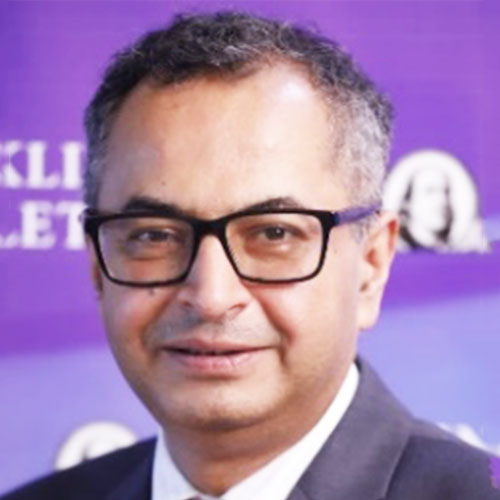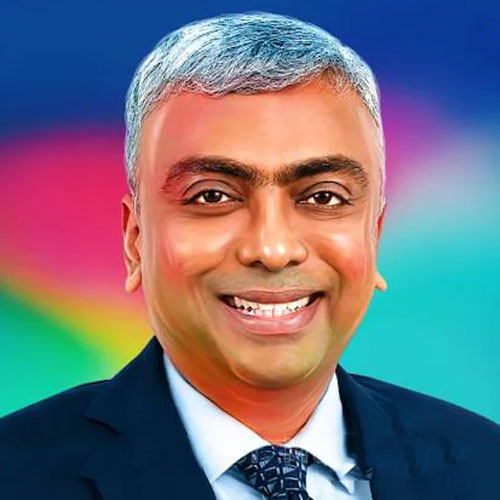Mr. Rahul Goswami
Chief Investment Officer & Managing Director - Fixed Income India
Franklin Templeton Asset Management (India) Pvt. Ltd.
Rahul Goswami is Chief Investment Officer (CIO) and Managing Director at Franklin Templeton, Fixed Income in India. In this role, Rahul oversees the fixed income functions of the locally managed and distributed debt schemes of Franklin Templeton Mutual Fund. Rahul was previously the CIO - Fixed Income at ICICI Prudential Asset Management (I-Pru) and a key contributor to the success of I-Pru’s fixed income funds in India. Prior to I-Pru, he was a member of the Franklin Templeton India Fixed Income team, serving as portfolio manager from 2002 to 2004. Rahul also brings a wealth of experience from his time at well-regarded banks such as Standard Chartered Bank and UTI Bank. He has over 25 years’ experience in managing fixed income funds.
Rahul earned his M.B.A. and his bachelor’s degree in science from Bhopal University.
Q1. RBI announced a 50-basis-point reduction in the Cash Reserve Ratio (CRR). How do you assess the impact of this move, especially in the context of rising global geopolitical tensions and inflationary pressures?
The CRR reduction to 4.00% in two tranches of 25 bps each is a move towards restoring the ratio to pre-April 2022 levels. The move is aimed at releasing approximately ₹1.16 lakh crore of primary liquidity into the banking system. RBI in its latest policy meeting suggested that the systemic liquidity is expected to tighten due to tax outflows, increase in currency in circulation and volatility in capital flows. This reduction is to enable banks to continue credit to businesses and consumers, leading to increased investment and consumption. Domestically, inflation has remained mostly within the RBI tolerance band and the volatility exhibited by the headline inflation is due to intermittent spike in vegetable and food prices and to an extent due to unfavorable base effects. Thus, we believe that the additional supply of money is not expected to be inflationary but only to compensate for the reduced liquidity.
Q2. With the RBI maintaining the status quo on policy rates in this month’s MPC meeting, what is your outlook for the next monetary policy review? Is a rate cut on the cards in February? If so, what could be the magnitude of the cut?
Policy moves by the RBI are determined by growth-inflation dynamics and macro stability. While the latest growth outlook for full year FY25 was tempered by 60 bps to 6.6%^ (Source: RBI Monetary Policy Committee dated 6th Dec 2024), it was largely a result of lower-than-expected GDP growth in the Q2FY25. Average real GDP growth, as per RBI projection, for the next four quarters i.e Q3FY25, Q4FY25, Q1FY26 and Q2FY26 are expected to be above 7%. At this juncture, it wants to remain prudent and practical and does not want the intermittent spike in headline inflation due to food prices volatility to spillover into other components of the inflation basket. It is difficult to predict the exact timing of rates cuts by the RBI, but we assess rate cuts in India to be shallow with two or three cuts of 25 bps each in CY 2025.
Q3. Will US 10-year bond yields cross 5% again? If yes, what would be its impact on emerging markets like India?
Looking at probable fiscal situation and growth-inflation dynamics in US, the neutral level for 10yr bond yield is in the range of 4.50-5.0%. This increase in US bond yields may pose challenges for emerging markets, as their bond yields must offer a suitably attractive rate of return. To make investing in these markets reasonable, one must consider hedging costs and ensure a return that surpasses the 4.5-5.0% yield of US bonds.
Q4. The RBI's downward revision of the GDP forecast to 6.6% from 7.2% raises concerns about the pace of economic recovery. Do you believe the Indian economy is on track to achieve its potential, considering current economic indicators?
RBI assesses the domestic activity to bottomed out in Q2:2024-25. In our assessment India's real GDP growth in Q2 at 5.4% is an aberration. The low GDP number is due to slowdown in industrial growth, particularly in manufacturing, mining, and electricity. However, high-frequency indicators suggest recovery, driven by strong festive demand and improved rural activities. Agricultural growth is supported by a healthy kharif crop and better rabi sowing. The services sector continues to expand robustly. Real GDP growth for 2024-25 is projected at 6.6%^, with Q3 at 6.8% and Q4 at 7.2%, indicating a resilient outlook. The next year’s quarterly growth outlook is estimated at 6.9% in Q1FY26 and 7.3% in Q2FY26. Overall, we feel that the growth might bounce back from the lows of Q2FY25 due to increased government spending and aided by strong high frequency indicators.
Q5. In light of a strong dollar and its global repercussions, how do you see currency movements affecting Indian investments?
RBI has been aware of the repercussions of a strong dollar and has been proactive to intervene from time to time. Financial markets have remained edgy amidst the rising US dollar and hardening bond yields, resulting in large capital outflows from emerging markets. Going forward, the outlook is clouded by rising tendencies of protectionism which have the potential to undermine global growth and push inflation higher. India, like other emerging markets is also likely to see volatility in asset prices.
Q6. We are in the last month of the year 2024 – any key learnings you would like to share?
We began the year with continued geopolitical risk amidst two ongoing wars. Then, developed economies started lowering rates, beginning with the European Central Bank, followed by the Bank of England. In September, the US Fed delivered a higher-than-expected cut of 50 bps, followed by two more cuts of 25 bps each (Source: US Federal Reserve Monetary Policy Documents dated 18th Sept, 7th Nov, 18th Dec 2024), cumulatively bringing down the rates by a full percentage point. Additionally, a Republican sweep in the US elections may lead to tariff changes and tax cuts, potentially causing disruptions and inflation. These factors have effectively added an element of uncertainty to the financial markets. We believe that the volatility we have seen in 2024 might continue for some more time, and therefore, we need to remain prudent and agile in our actions to rebalance our investment portfolio from time to time.
Disclaimer: This document has been issued on the basis of internal data, publicly available information and other sources believed to be reliable. The information contained in this document is for general purposes only and not a complete disclosure of every material fact. The sector, instruments and securities mentioned herein are for general assessment purpose only and not a complete disclosure of every material fact. It should not be construed as investment advice to any party. The information / data herein alone is not sufficient and shouldn’t be used for the development or implementation of an investment strategy. It should not be construed as investment advice to any party. Past performance may or may not be sustained in future. The article does not warrant the completeness or accuracy of the information and disclaims all liabilities, losses and damages arising out of the use of this information. The statements contained herein may include statements of future expectations and other forward-looking statements that are based on our current views and assumptions and involve known and unknown risks and uncertainties that could cause actual results, performance or events to differ materially from those expressed or implied in such statements. Readers shall be fully responsible/liable for any decision taken on the basis of this document.
Mutual Fund investments are subject to market risks, read all scheme related documents carefully.






